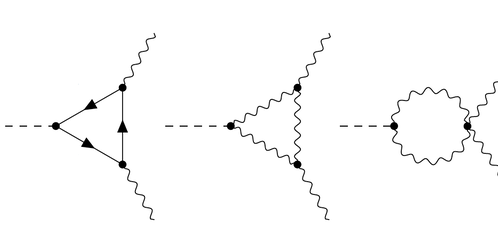Measurements of Rare Higgs Decay May Disagree with Predictions
For particle physics, 2012 was a milestone year with the discovery of the Higgs boson, which until then was the only missing particle in the list predicted by the standard model. That discovery didn’t stop the search for new particles, which researchers have continued by undertaking precise measurements of rare particle decays. Evidence for new particles could show up as a deviation from standard-model predictions of the numbers of such decays. Now CERN’s ATLAS and CMS collaborations have together spotted an overabundance of a previously unseen rare decay involving the Higgs boson [1].
The standard model predicts that the decay of 15 of every 10,000 Higgs bosons will result in the creation of a Z boson and a photon. In the standard model, this decay is mediated by a top quark or a W boson. But models that go beyond the standard model indicate that the decay could also be mediated by one or more unknown particles.
To explore this possibility, the ATLAS and CMS collaborations searched for signals of Higgs decay to a Z boson and a photon in proton–proton collision data recorded between 2015 and 2018. Z bosons decay into two electrons or two muons before they reach detectors, so scientists devised methods to determine whether the electron, muon, and photon signatures found in the data originated from Z-boson–photon events. From those events, they then selected the ones having the properties expected for a Higgs-boson decay, finding twice as many as predicted by the standard model. Currently, the data are insufficient to rule out the possibility that this discrepancy is a statistical fluctuation. Nevertheless, the researchers say that this work offers a new path to stress testing the standard model.
–Nikhil Karthik
Nikhil Karthik is an Associate Editor for Physical Review Letters.
References
- G. Aad et al. (ATLAS Collaboration, CMS Collaboration), “Evidence for the Higgs boson decay to a Z boson and a photon at the LHC,” Phys. Rev. Lett. 132, 021803 (2024).




